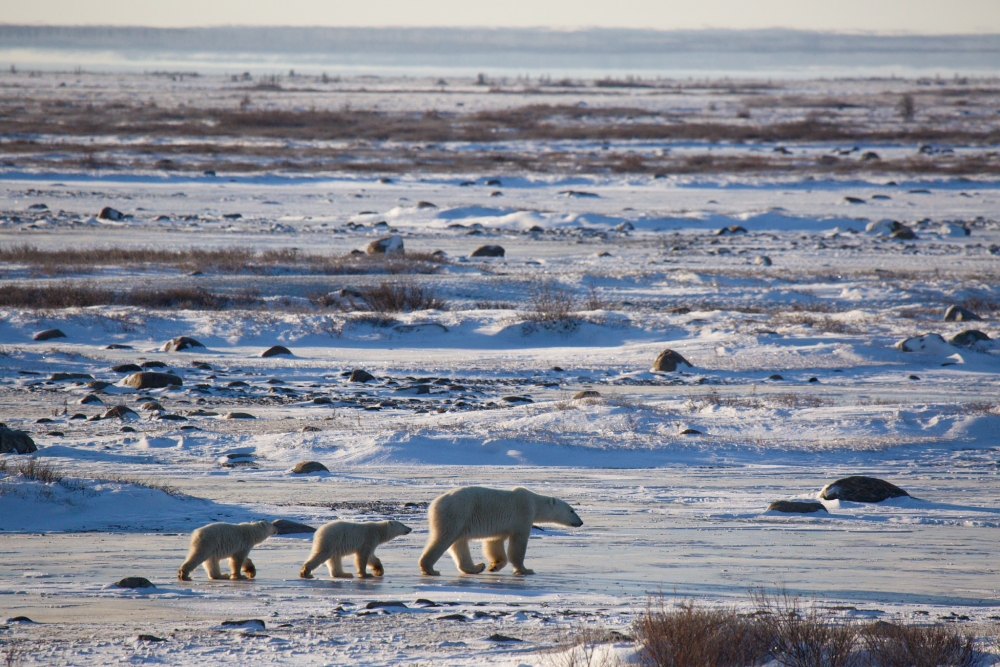Polar bears are the world’s largest land carnivore, growing up to 3 meters (10 feet) in length and weighing over 800 kilograms (1,700 pounds), but did you know that they begin life no bigger than a stick of butter? With a birthweight of around 500 grams (17 ounces), polar bear cubs pop out about 1/400th the size of mom, but luckily, the magic of polar parenting has been caught on camera.
The den visualization footage was shot in captivity and provided by Polar Bears International’s zoo partners at Toledo Zoo & Aquarium. It shows the newborn polar bear cubs against their mother’s comparatively massive snout, resting ahead of the big job of beefing up her tiny polar bear babies.
To find out more about how these tiny wee butter-stick babies survive and – for the lucky ones – live long enough to grow to around 400 times their birthweight, IFLScience marked International Polar Bear Day by speaking to Alysa McCall, Polar Bears International Director of Conservation Outreach and Staff Scientist. As it turns out, growing from a blind, toothless ball of fine fluff into the world’s largest land predator involves bulking up thick and fast.
Where do polar bear cubs come from?
Alysa McCall: Polar bear gestation is only about a couple months. After a female successfully mates out on the sea ice, the fertilized egg undergoes a small number of divisions and then enters a state known as delayed implantation.
The fertilized egg develops no further until autumn, around October, when the female’s body “decides” whether it has enough fat stored to be able to have cubs. If the answer is no, the fertilized egg is either shed or reabsorbed. If the answer is yes, the fertilized egg(s) will then implant and the growth of the cubs begins, with the birth of the tiny cubs taking place only a couple of months later in about December.
How quickly do polar bear cubs develop?
AM: The cubs grow rapidly on their mother’s rich milk which is ~31 percent fat when cubs are born – the fattiest milk we find on land. By 3 months old, cubs may weigh ~10–12 kilograms (22-26 pounds), meaning they’ve grown approximately 20 times their original body weight in 12 weeks. If newborn humans did this, we’d need adult-size bassinets.

“By 2 years old, male cubs can be as big as their moms.”
Image credit: KT Miller / Polar Bears International
Cubs continue growing rapidly, more than doubling their weight between den emergence and their first birthday, and yet again between their first and second birthdays. By 2 years old, male cubs can be as big as their moms and weigh hundreds of pounds. The mother bear’s rich milk is a significant contributor to the rapid growth of cubs but comes at a significant cost to mom.
What are some of the toughest challenges faced by polar bear cubs and moms?
AM: Polar bear moms have an incredibly tough job. They have only about 2.3 years to teach their cubs how to be successful polar bears, including how to find and hunt prey, how to navigate their shifting sea ice habitat, how to avoid dangers like adult male polar bears, and seasonal migration patterns.
This gets even harder when you consider how fast their sea ice habitat is already changing in some parts of their range. Not to mention that moms are continuously nursing; though their milk fat content decreases as cubs age, lactation is incredibly energetically costly to mom.
What questions are Polar Bears International hoping to answer with their den research?
AM: Cub survival rates can vary greatly by region and annual sea ice conditions, but on average only about 50 percent of cubs live past their first year. In parts of the Arctic with more sea ice loss, cub survival rates are even lower.
It is critical that we work to protect vulnerable moms and cubs which we are doing through a variety of research projects. Better understanding the needs of denning families is vitally important especially as human activities increase across the Arctic. Such knowledge can make a real difference for polar bear families – providing a scientific framework to inform policy and help ensure critical protections.
Our long-term den emergence studies in Alaska and Svalbard add to our understanding of moms and cubs during this sensitive time period – providing data on their needs and vulnerabilities. One of our studies focused on how denning families react to disturbances – data that directly relates to oil and gas development and other human activities. The findings underscore the importance of adequate buffer zones to shield moms and cubs from harm.
Another study found that current den-detection surveys, conducted by the oil and gas industry to locate and hence protect polar bear dens, have been missing over half of known dens. The high failure rate has implications for policy decisions in sensitive denning areas like the Arctic National Wildlife Refuge.
Our team is now researching a promising new den-detection method that could greatly improve our ability to locate dens under the snow, helping to identify and protect denning areas to ensure the safety of moms and cubs.
How can people support polar bear cubs this International Polar Bear Day?
AM: Tune in to our events. Watch a video dispatch from our den study team in Svalbard, Norway, and join us for a live Q&A with staff in Churchill, Manitoba, Canada. Find the schedule and details here.
Donate to protect moms and cubs. From better understanding the denning period, to protecting moms and cubs from disturbances, and addressing the overarching threat of climate change, your gift will help polar bear families.
Source Link: The World’s Largest Bear Begins Life As A Fluffy Stick Of Butter